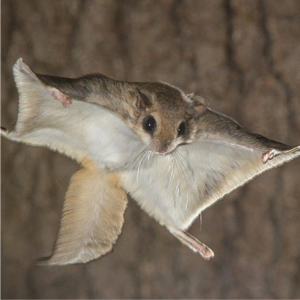The Flying Squirrel

- Distribution: North America, Europe, Asia (varies by species)
- Habitat: Deciduous and coniferous forests, woodlands
- Diet: Fruits, nuts, seeds, fungi, insects, bird eggs
- Size: Varies by species; typically body length 20-30 cm; tail length 15-25 cm
Appearance:
- Flying Squirrels vary in size depending on the species, but they typically have a flattened tail that acts as a stabilizer during flight.
- Their fur coloration varies widely among species, ranging from shades of brown, gray, to reddish hues.
- They have large eyes adapted for low-light vision, as they are primarily nocturnal.
Habitat:
- Flying Squirrels are found in various habitats, including temperate and tropical forests, as well as montane forests.
- They prefer forests with tall trees that provide ample height for gliding between trees.
Behavior:
- They are nocturnal, being most active during the night, and spend their days resting in tree cavities or nests.
- Flying Squirrels are arboreal and adept climbers, using their sharp claws to grip tree bark.
- They do not actually fly but glide using their patagium, which allows them to travel distances of up to 150 meters (490 feet) between trees.
Diet:
- Their diet consists primarily of nuts, seeds, fruits, and occasionally insects.
- They play a role in forest ecology by dispersing seeds and contributing to the regeneration of plant species.
Distribution:
- Flying Squirrels are found in various parts of the world, including North America, Europe, Asia, and parts of Africa.
- Different species have adapted to specific geographical regions and habitats within these continents.
